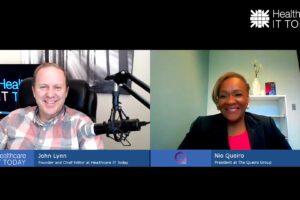Nuance Communications, maker of the Dragon family of dictation software products, Is introducing a new option to its flagship product making it possible to find clinical information using voice search tools.
This comes as part of a broader initiative in which Nuance is working to entrench itself in next-generation voice search, clinical workflows and ultimately, the use of AI to create documentation from unforced clinical conversations.
Currently, Nuance is announcing that clinicians using its Dragon Medical One will now be able to use voice prompts to find relevant information from Wolters Kluwer’s UpToDate clinical decision support information. The voice search capability, Clinical Content Search, is one of several embedded skills available in Dragon Medical One.
It uses what Nuance calls “conversational intelligence” to dig up clinical information in response to natural questions. The content it can retrieve includes medication dosage schedules, disease states, drug interactions, clinical calculators, and side effect symptoms.
One healthcare organization implementing this capability is Vanderbilt University Medical Center, which is investing considerable time and energy in making voice-driven access to information available.
VUMC has been working on voice-control capabilities for some time. Its efforts include building virtual assistant software allowing team members to verbally request information from their Epic EHR. This assistant has been named EVA, which is short for EHR Voice Assistant. Epic has been working with VUMC on the project.
This all dovetails with other efforts by Epic, which certainly isn’t limiting itself to under-the-radar voice search projects. Before the HIMSS20 show was canceled due to pandemic concerns, Epic had planned to debut its own voice assistant, dubbed “Hey, Epic!”
Using this technology, clinicians will be able to say “Hey Epic” to summon the assistant, which as of February was in use by roughly 20 organizations. Hey Epic can place orders, call members of a patient’s care team, create reminders, and more. VUMC seems pretty convinced that this approach to clinical information sharing is valuable.
Circling back to Nuance, it’s clear that deals like the one with Wolters Kluwer represent just the tip of the iceberg when it comes to extending the power of voice-driven clinical workflow. While this one feature may be great, it’s just one of many things Nuance needs to do to keep its tools relevant to next-gen clinical users.
To that end, Nuance has been extending its capabilities into AI-driven healthcare documentation technology. Late last year, the company announced that it was working with Microsoft to deploy “ambient clinical intelligence” technologies that will write clinical documentation automatically on behalf of doctors.
According to the two companies, ACI will “listen” to clinical conversations doctors have with patients, integrate this content with other background information from the EHR, and generate a medical summary automatically. Nuance has announced this new product as Nuance DAX and you may remember that John suggested that every telehealth company should consider integrating it into their telehealth documentation solution.
As interesting, attractive, and helpful these voice-driven capabilities are — and summoning clinical decision support will probably be quite helpful — automated documentation is the real prize here. Although, maybe this new voice search will incorporate the information from the clinical research alongside the documentation.
The future lies in transforming the way in which systems listen to clinicians and build on what they hear. This is the next great leap for man-machine voice interfaces. If Nuance plays its cards right it could be one of the first vendors to entrench itself in this space.













